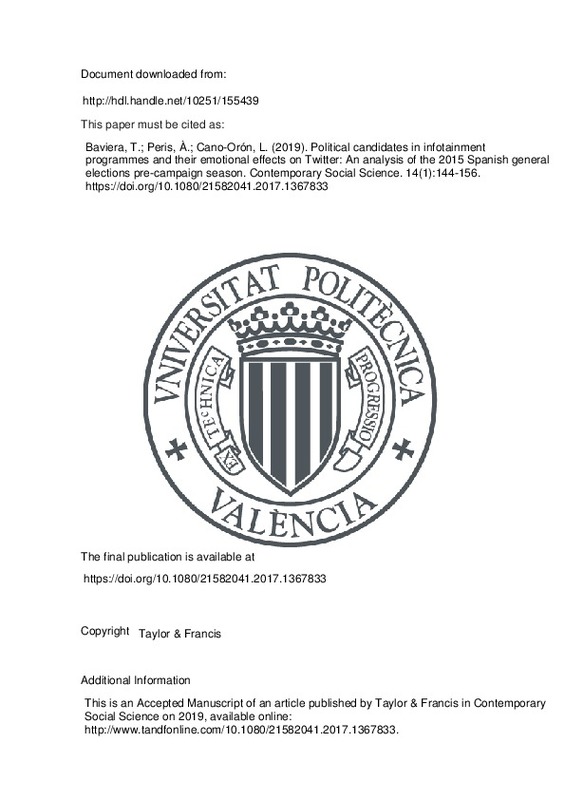Baum, M. A., & Jamison, A. S. (2006). TheOprahEffect: How Soft News Helps Inattentive Citizens Vote Consistently. The Journal of Politics, 68(4), 946-959. doi:10.1111/j.1468-2508.2006.00482.x
Bravo-Marquez, F., Mendoza, M., & Poblete, B. (2014). Meta-level sentiment models for big social data analysis. Knowledge-Based Systems, 69, 86-99. doi:10.1016/j.knosys.2014.05.016
Casero-Ripollés, A., Feenstra, R. A., & Tormey, S. (2016). Old and New Media Logics in an Electoral Campaign. The International Journal of Press/Politics, 21(3), 378-397. doi:10.1177/1940161216645340
[+]
Baum, M. A., & Jamison, A. S. (2006). TheOprahEffect: How Soft News Helps Inattentive Citizens Vote Consistently. The Journal of Politics, 68(4), 946-959. doi:10.1111/j.1468-2508.2006.00482.x
Bravo-Marquez, F., Mendoza, M., & Poblete, B. (2014). Meta-level sentiment models for big social data analysis. Knowledge-Based Systems, 69, 86-99. doi:10.1016/j.knosys.2014.05.016
Casero-Ripollés, A., Feenstra, R. A., & Tormey, S. (2016). Old and New Media Logics in an Electoral Campaign. The International Journal of Press/Politics, 21(3), 378-397. doi:10.1177/1940161216645340
Ceron, A., & Splendore, S. (2016). From contents to comments: Social TV and perceived pluralism in political talk shows. New Media & Society, 20(2), 659-675. doi:10.1177/1461444816668187
Chadwick, A. (2013). The Hybrid Media System. doi:10.1093/acprof:oso/9780199759477.001.0001
Dang-Xuan, L., Stieglitz, S., Wladarsch, J., & Neuberger, C. (2013). AN INVESTIGATION OF INFLUENTIALS AND THE ROLE OF SENTIMENT IN POLITICAL COMMUNICATION ON TWITTER DURING ELECTION PERIODS. Information, Communication & Society, 16(5), 795-825. doi:10.1080/1369118x.2013.783608
Giglietto, F., & Selva, D. (2014). Second Screen and Participation: A Content Analysis on a Full Season Dataset of Tweets. Journal of Communication, 64(2), 260-277. doi:10.1111/jcom.12085
Grabe, M. E., & Bucy, E. P. (2009). Image Bite Politics. doi:10.1093/acprof:oso/9780195372076.001.0001
Guo, L., & Vargo, C. (2015). The Power of Message Networks: A Big-Data Analysis of the Network Agenda Setting Model and Issue Ownership. Mass Communication and Society, 18(5), 557-576. doi:10.1080/15205436.2015.1045300
Harrington, S. (2008). Popular news in the 21st century Time for a new critical approach? Journalism: Theory, Practice & Criticism, 9(3), 266-284. doi:10.1177/1464884907089008
López-Rico, C.-M., & Peris-Blanes, À. (2017). Agenda e imagen de los candidatos de las elecciones generales de 2015 en España en programas televisivos de infoentretenimiento. El Profesional de la Información, 26(4), 611. doi:10.3145/epi.2017.jul.05
Maruyama, M., Robertson, S. P., Douglas, S., Raine, R., & Semaan, B. (2017). Social Watching a Civic Broadcast. Proceedings of the 2017 ACM Conference on Computer Supported Cooperative Work and Social Computing. doi:10.1145/2998181.2998340
Medhat, W., Hassan, A., & Korashy, H. (2014). Sentiment analysis algorithms and applications: A survey. Ain Shams Engineering Journal, 5(4), 1093-1113. doi:10.1016/j.asej.2014.04.011
Saif, H., He, Y., & Alani, H. (2012). Semantic Sentiment Analysis of Twitter. Lecture Notes in Computer Science, 508-524. doi:10.1007/978-3-642-35176-1_32
Shah, D. V., Hanna, A., Bucy, E. P., Lassen, D. S., Van Thomme, J., Bialik, K., … Pevehouse, J. C. W. (2016). Dual Screening During Presidential Debates. American Behavioral Scientist, 60(14), 1816-1843. doi:10.1177/0002764216676245
Sullivan, D. G., & Masters, R. D. (1988). «Happy Warriors»: Leaders’ Facial Displays, Viewers’ Emotions, and Political Support. American Journal of Political Science, 32(2), 345. doi:10.2307/2111127
Thelwall, M., Buckley, K., Paltoglou, G., Cai, D., & Kappas, A. (2010). Sentiment strength detection in short informal text. Journal of the American Society for Information Science and Technology, 61(12), 2544-2558. doi:10.1002/asi.21416
Vergeer, M., & Franses, P. H. (2015). Live audience responses to live televised election debates: time series analysis of issue salience and party salience on audience behavior. Information, Communication & Society, 19(10), 1390-1410. doi:10.1080/1369118x.2015.1093526
Vilares, D., Thelwall, M., & Alonso, M. A. (2015). The megaphone of the people? Spanish SentiStrength for real-time analysis of political tweets. Journal of Information Science, 41(6), 799-813. doi:10.1177/0165551515598926
Wohn, D. Y., & Na, E.-K. (2011). Tweeting about TV: Sharing television viewing experiences via social media message streams. First Monday. doi:10.5210/fm.v16i3.3368
[-]







![[Cerrado]](/themes/UPV/images/candado.png)


